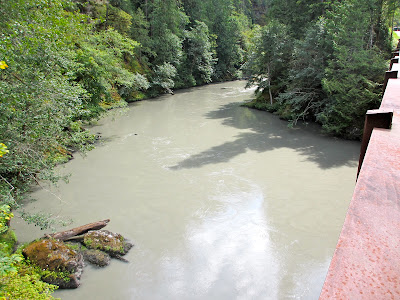 |
| Swain's Sporting Goods in Port Angeles, where we got a couple dog leashes |
The Elwha Dam was completed in 1915. The Gilnes Canyon Dam, further upriver, was completed in 1927. Before the dams were built, the Elwha was the richest salmon stream in the Straits of Juan de Fuca, and the only river in the Greater Puget Sound area to host all five salmon species. After construction, most of the salmon population was terminated.
The removal project is the largest controlled dam removal project in the history of the world. It is the second largest ecological restoration project in the history of the U.S. National Park system, after he Everglades Park restoration.
Long-range plans call for major restoration of an ecosystem that was long submerged under artificial lakes, and covered with thick layers of glacial silt. The direct restoration efforts are already well underway.
Here's our trip gallery:
Map of closed areas during the dam deconstruction:
Judy on the bridge over the Elwha, where the Olympic Hot Springs road is now closed:
Looking upriver from the bridge. The river, picking up on the exposed silt layers, is very silt laden:
Looking through the shrouding obscuring the removal of Glines Canyon Dam:
A closer view through the peek hole somebody - not us - poked:
I snuck around the blind fence to get a closer view:
Looking down on the dam, from the Whiskey Bend trailhead road. The upper dam deconstruction is ahead of schedule, with almost 90% of the lake's volume evacuated:
The river just above where Lake Aldwell used to be:
Above the reconstructed Elwha Dam, exposed part of the former Lake Aldwell:
A Washington Conservation Corps crew, relaxing after finishing a long day eliminating invasive plants from the newly liberated areas exposed by Aldwell Lake's removal:
A Forget-me-not, growing where Lake Aldwell used to be:
The site of the former Elwha Dam, with evidence of some of the restoration efforts at the dam site:
Judy and Andy, engaging a retired U.S. Navy nuclear submariner (a lot of them live in Kitsap and Clallam counties) on the merits of green projects and sustainability:
We didn't go down to the delta of the Elwha,where it enters the Straits. Here is an excellent article on the delta and the effects of the silt, by Lynda V. Mapes, for the Seattle Times.
One of the most important aspects of this project are its ramifications for similar projects elsewhere. The two most important longterm ones are the Klamath River restoration and the Toulumne River in Yosemite National Park, site of Hetch Hetchy Dam, whose reservoir inundated the magnificent Hetch Hetchie Valley. The latter dam removal plan is in the news, as California voters consider the costs and ramifications of removal:
This fall San Franciscans will vote on a local measure with national implications: It could return to the American people a flooded gorge described as the twin of breathtaking Yosemite Valley.
Voters will decide whether they want a plan for draining the 117-billion-gallon Hetch Hetchy reservoir in Yosemite National Park, exposing for the first time in 80 years a glacially carved, granite-ringed valley of towering waterfalls 17 miles north of its more famous geologic sibling.
The November ballot measure asks: Should city officials devise a modern water plan that incorporates recycling and study expansion of other storage reservoirs to make up the loss? The measure could eventually undo a controversial century-old decision by Congress that created the only reservoir in a national park and slaked the thirst of a city 190 miles away.
The battle over Hetch Hetchy, first waged unsuccessfully by naturalist John Muir, had turned the Sierra Club from an outdoors group into an environmental powerhouse.
The fight gained momentum in recent years when unlikely allies joined forces. On one side are Republican lawmakers and environmentalists, including Ronald Reagan's former interior secretary, who want the dam removed and valley restored.
On the other are Democratic San Franciscans, led by Sen. Dianne Feinstein and Rep. Nancy Pelosi, fighting to hold onto the city's famously pure drinking water in a drought-prone state.The importance of the Elwha project is that now we can say "It CAN be done!"















1 comment:
Phil, Judy and Andy did a great service in bringing this success to the people across the Pacific NW and around the country.
Years of hard work by dedicated advocates, including thousands of people in fishing communities and organizations, raised the issues and problems of these dams and those discussed in California and Oregon. Then they all turned their efforts on the Elwha watershed. Then they prevailed. Sustainability and natural systems make enough sense that more similar victories on both coasts are possible.
It is now time for the entire environmental community and Democratic voters to focus on convincing Nancy Pelosi and alleged Democrat Diane Feinstein to change their minds and support the removal of Hetch Hetchy.
Post a Comment